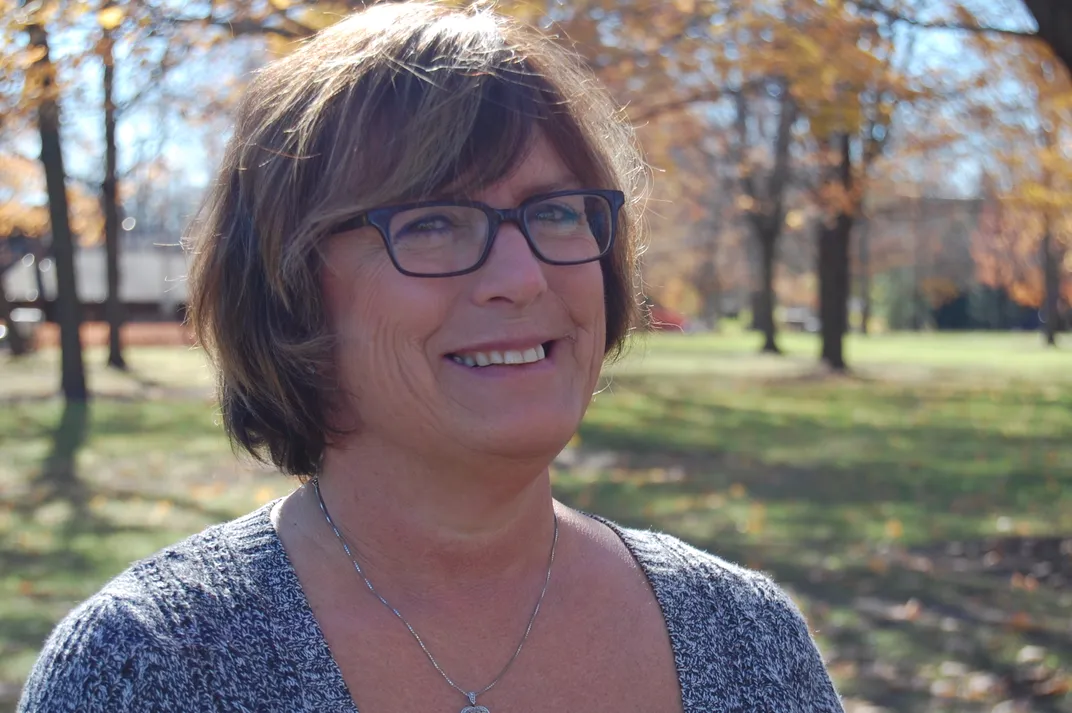Designing Glasses That Fit Individuals With Down Syndrome
Optician Maria Dellapina started Specs4Us when her daughter struggled to find a pair of glasses that wouldn’t slip
:focal(342x58:343x59)/https://tf-cmsv2-smithsonianmag-media.s3.amazonaws.com/filer/6e/f4/6ef4b92b-00af-4e9c-b722-6ce51ddc1998/nicol_hudson_2_2.jpg)
Maria Dellapina’s daughter Erin first needed glasses when she was 22 months old. Erin has Down Syndrome, and Dellapina, who had been a frame buyer and optician, figured she could easily source the smallest, cutest glasses for her toddler. Instead, she couldn’t find a single pair that properly fit Erin’s face.
Of the approximately 6,000 children born in the U.S. with Down Syndrome each year, more than half will need glasses at some point. Some of the physical traits associated with Down Syndrome, including close-set eyes, a low nose bridge and small ears, mean that glasses tend to slip down individuals' noses, wing out too wide in the temples and not stay centered on their ears. The glasses that are available are uncomfortable, uncool, and, since the optical center tends to be off, not very helpful, vision-wise.
“The standard solution for the slippage was a cable around the back of the head,” says Dellapina, “but parents who put them on their kids have never tried them themselves.”

Since she was already familiar with optics and frame design, Dellapina started sketching out alternatives. “I could draw out what could be done to fit differently,” she says. “I lowered the bridge placement to the center of the eye wire and lifted the frame up, so they could look through the optical center.”
Despite Dellapina's connections in the optical world, she couldn’t find anyone to take up her frame design. She was told the redesigned glasses would be too hard to make, or that there wasn’t enough of a need for them, even though there are more than 400,000 people with Down Syndrome in the U.S. alone. Dellapina, a single mother with four kids, had lost her job and was struggling to find work, when she was looking to turn her sketches into a product.
In 2007, she sent her designs to a reputable South Korean frame maker. “He sent them back, but the next morning I get a phone call from him and he said, ‘Whatever it is you’re trying to do I’m going to help you do it.’” They made eight prototypes and sent them out to some bloggers who write about Down Syndrome to test. "It has made a HUGE difference!" Qadoshyah, a blogger from Oklahoma, wrote when her brother, who has Down Syndrome, wore a pair. "These frames would work so well just for any little kid who doesn't have much of a nose bridge." With positive feedback, Dellapina placed an order for three models and took them to the 2008 convention of the National Down Syndrome Congress in Boston.
“We sold 28 pairs, but we came back with seven pages of people who wanted them,” she says.

She ordered a first big run from the South Korean factory, and the shipment showed up in Ohio at Specs4Us on June 3, 2008—Erin’s birthday. Business spread, predominantly through word-of-mouth recommendations. Now, the company offers 14 models in 23 colors and infant through adult sizing.
Fit isn’t the only difference. Individuals with Down Syndrome can have sensory issues with rubber and other textures, some of them wear hearing aids, and they tend to be harder on glasses, so Dellapina found ways to tweak the material, too, to make her glasses light and strong.
Maybe it’s because Erin is a teenager now, but Dellapina gives special attention to the aesthetics of the glasses. She thinks glasses should look like an accessory, not a medical device, so she has developed different frame styles and colors. “Maybe they won’t outgrow them but they will want another style. Nobody wants to wear the same frame forever,” she says.
Toyota recently awarded Dellapina a $50,000 “Mother of Invention” grant to continue her work. As part of this honor, she will be speaking tomorrow at the Women in the World Summit in New York City.
“That was kind of my attagirl moment,” she says. “When you’re a single mom running a company you don’t have a lot of people patting you on the back. But I’m having the best time in the world right now knowing that I can help more than just my daughter.”
/https://tf-cmsv2-smithsonianmag-media.s3.amazonaws.com/accounts/headshot/DSC_0196_2.JPG)
/https://tf-cmsv2-smithsonianmag-media.s3.amazonaws.com/accounts/headshot/DSC_0196_2.JPG)